Last updated on June 6th, 2025 at 06:16 pm
- Many seniors struggle with standing exercises due to pain or disability.
- Chair exercises offer a safe, seated alternative to maintain mobility.
- This guide covers head-to-toe movements for flexibility, strength, and pain relief.
- No equipment needed – just a sturdy chair.
The chair exercises for seniors are a set of exercises that are all performed seated on a chair without the use of any equipment. These exercises will be helpful for those elderly who have difficulty exercising while standing or who have osteoarthritis knee, hip pain, or knee joint pain.
In this article, I will show some exercises you can perform while sitting in a chair.
10-Minute Seated Chair Exercises for Seniors (Full Body)
Many elderly people cannot exercise in a standing position, which could be due to pain or disability. However, they should not refrain from doing exercises that are crucial to their quality of life.
We are presenting here a list of straightforward chair exercises that can quickly be learned and performed by them. We are covering exercises from head to toe in a straightforward manner. Let us start with neck exercises.
Seated Neck Exercises for Senior Pain Relief
The first group of exercises is meant to exercise the neck and cervical area. These exercises will give almost instant relief from neck pain. These exercises are meant for normal neck stiffness and pain.
Suppose you have neck pain with radiation to the hand or are diagnosed with C4-C5-C6 disc hernia. In that case, we suggest the following exercises in this article titled 7 Easy Neck Exercises For Pinched Nerve To Cure Cervical Radiculopathy Permanently.
#1 Neck side bend
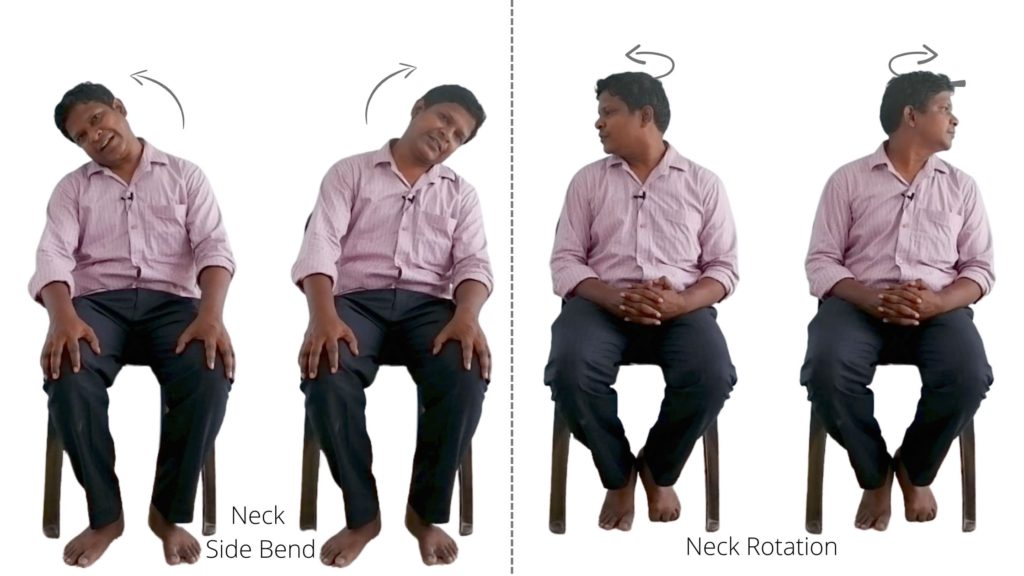
If you’re a senior feeling stiffness and tension in your neck, the first exercise for you – is the neck side bend. This exercise is easy to do and will help improve your neck flexibility. So, let’s get started.
- Sit comfortably in a chair with your back straight and feet flat on the ground.
- Tilt your head to the right, bringing your ear towards your shoulder.
- Hold for 10-15 seconds, then slowly return to center.
- Now, repeat on the left side.
- Do this 3-5 times on each side, taking deep breaths and relaxing your shoulders.
#2 Neck rotation
The following exercise is neck rotation for neck rotation. This exercise is beneficial for seniors, as it helps to maintain and improve the range of motion in the neck.
- To perform this exercise, start by sitting comfortably with your back straight.
- Slowly turn your head to the right, keeping your chin parallel to the ground until you feel a gentle stretch in your neck.
- Hold this position for a few seconds, then slowly return your head to the centre.
- Repeat the same movement, this time turning your head to the left.
- Continue alternating between left and right, repeating the exercise 10-15 times on each side.
- Remember to keep your movements slow and controlled and to stop immediately if you feel any pain or discomfort.
#3 Neck flexion-extension
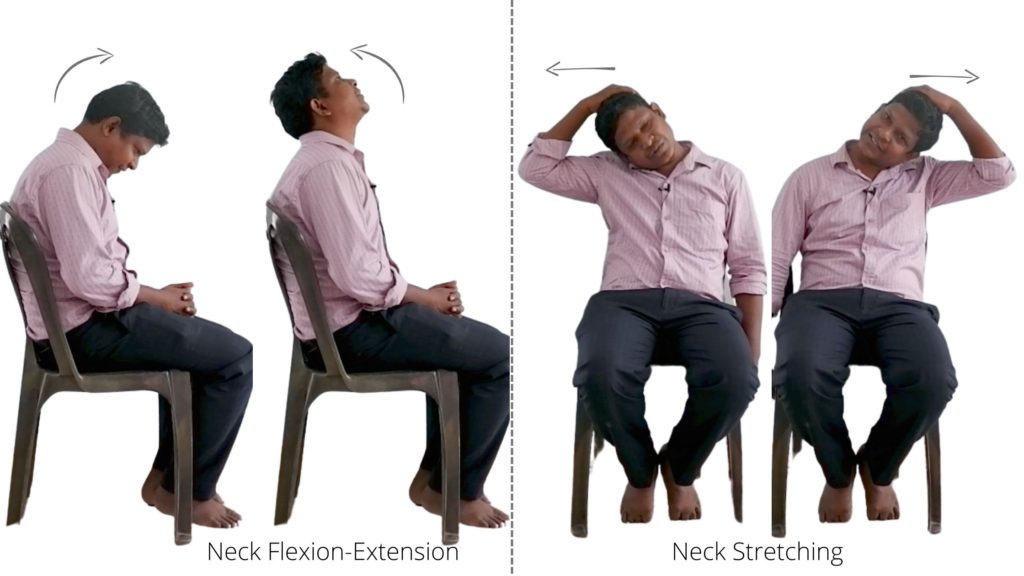
Then comes neck flexion and extension, which means we have to bend the neck forward and then bend backwards this way. Many people may question whether neck bending is avoided in neck pain.
Still, if you don’t have a significant issue, such as a disc bulging in the cervical area, then you won’t have any problems in doing neck bending exercises; you can do it comfortably.
- To perform this exercise, sit up straight with your shoulders relaxed.
- Start by looking straight ahead, then slowly tuck your chin towards your chest while keeping your back straight.
- Hold this position for a few seconds, then slowly raise your head to the starting position.
- Next, slowly tilt your head back while looking up towards the ceiling.
- Hold this position for a few seconds, then slowly lower your head to the starting position.
- Repeat this exercise 5-10 times or as your healthcare provider recommends.
#4 Neck stretching
For the next exercise, we will focus on stretching your neck muscles on both the right and left sides.
- Place your right hand on your left temple region just above the ear.
- Gently pull your head to the right side until you feel a comfortable stretch on the left side muscle.
- Hold this position for 30 seconds, and then release it and relax.
- To stretch the right side neck muscle, use your left hand to pull it to the right side until you feel a comfortable stretch on the right side muscle.
- Hold this position for 30 seconds, and then release it and relax.
- It’s important to note that this is a stretching exercise, so it’s recommended to do it 2-3 times in a session.
Seated shoulder exercises to improve mobility
These were neck exercises; now, we go to shoulder exercises. There are several shoulder exercises which will relax your stiff shoulder and give comfort to muscles around the shoulder joints.
These exercises are shoulder abduction exercises, triceps strengthening exercises, and shoulder shrugs. However, suppose you suffer from shoulder pain and can perform exercises in a standing position.
In that case, we highly suggest the following exercises in one of my previous articles 12 Easy Rotator Cuff tear Exercises for Shoulder Pain Relief.
Let us begin with the shoulder abduction exercise.
#5 Shoulder abduction
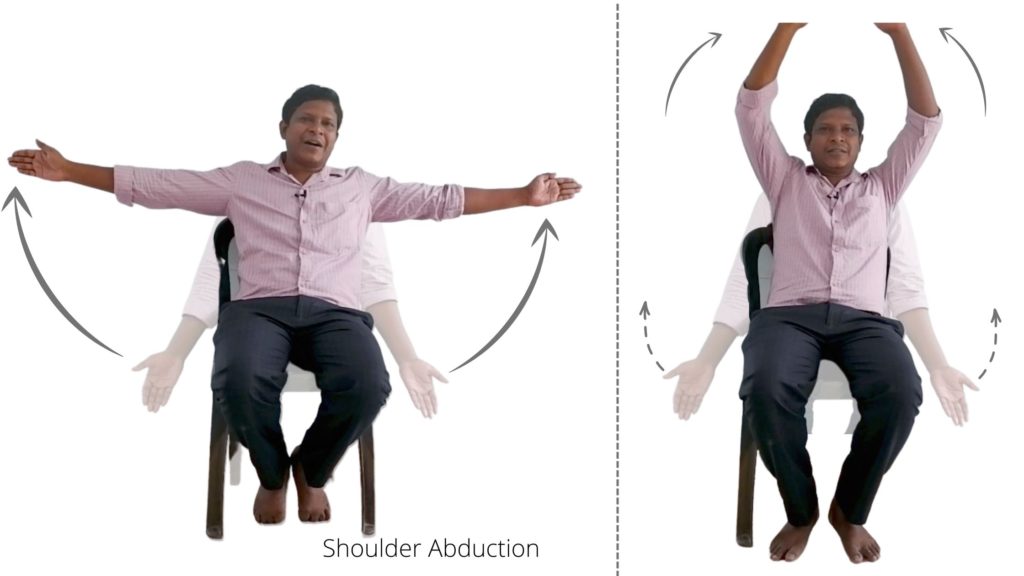
Shoulder abduction is a movement that involves lifting the shoulder away from the body.
- To perform this exercise, keep your hand by your side with your palm facing forward. Do not let your palm face inward.
- To lift your shoulder, raise it to 90 degrees and hold it there for 5 seconds. Then, relax and repeat the movement.
- You can perform this exercise 10 times.
- Similarly, you can perform the shoulder flexion exercise. For this, keep your hand by your side with your palm facing inward and lift it to 90 degrees.
- Hold it there for 5 seconds, then relax and repeat the movement.
- You can repeat this exercise 10 times as well. Remember to perform each exercise 10 times to get the maximum benefit.
#6 Triceps strengthening chair exercises for seniors
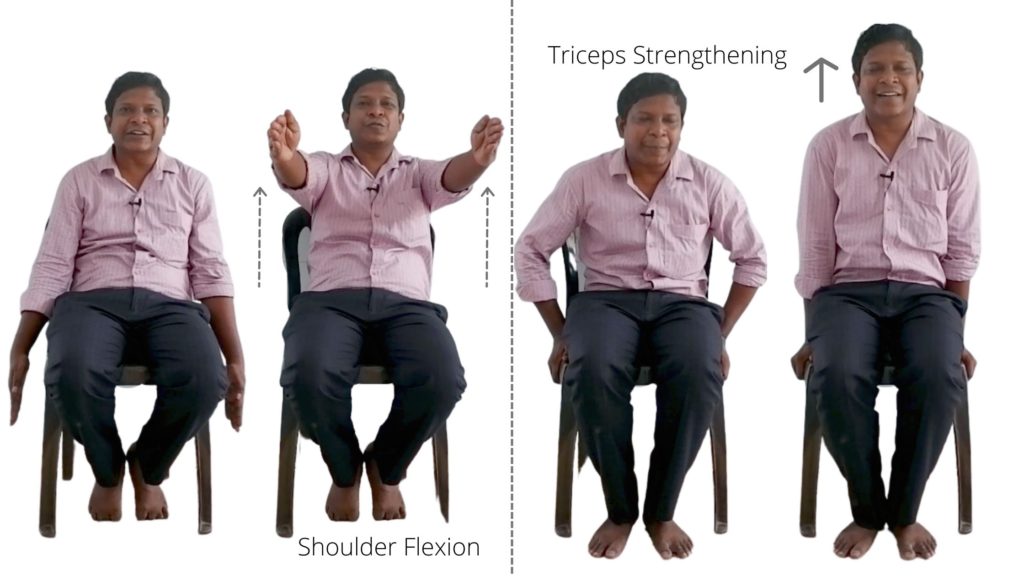
It’s important not to neglect the triceps muscle when doing shoulder exercises. The triceps muscle is located on the back of the arm and gives it a bulky appearance.
- To strengthen this muscle, sit straight on a chair and place your hands firmly on the side of the chair.
- Gently lift your body using the power of your arms and forearms without using your legs. Look at the accompanying figure to see how this motion is performed. This exercise will help to strengthen your triceps muscles.
#7 Shoulder shrug
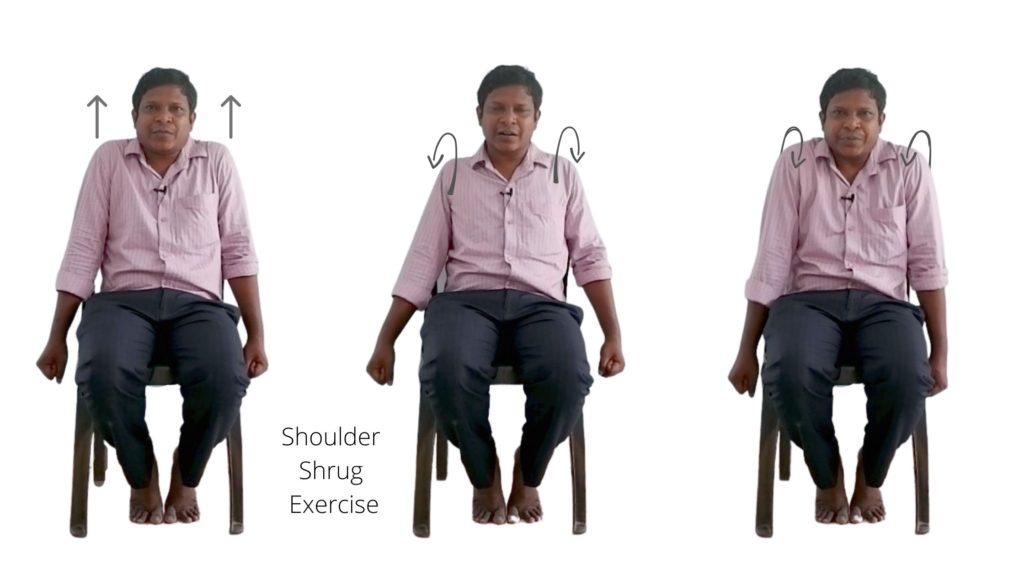
The next exercise is the shoulder shrug, which involves three different shoulder motions.
- To perform this exercise, sit straight on a chair with your arms down at your sides.
- First, lift your shoulders straight up, as shown in the figure. Do this ten times.
- This is the first motion. Then, rotate your shoulders forward ten times, followed by ten backward rotations.
- It would be best if you repeated these motions ten times each: lifting, forward rotation, and backward rotation.
Also read: Mental health actually improves in seniors using social media
Upper back seated exercise (no equipment needed)
#8 Upper back stretching and March exercises
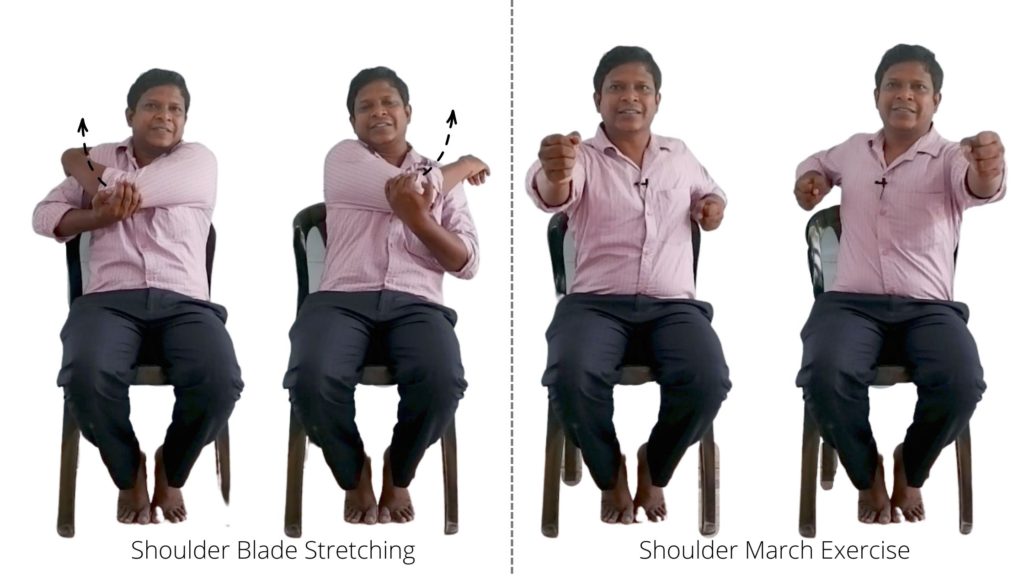
Upper back pain is a common issue that can result from stiff upper back muscles. To alleviate this discomfort, there are a couple of exercises you can do. The first one is a stretching exercise that focuses on the shoulder blade muscles.
- To stretch the muscles on the left side of your upper back, lift your arm in front of your chest and place your right hand on your elbow, then pull your elbow towards your chest.
- You should feel a comfortable stretch on the left side of your upper back. Hold this position for 30 seconds before relaxing.
- To stretch the muscles on the right side of your upper back, use your left hand on your right elbow instead. Repeat this exercise 2-3 times in a session.
Another exercise that can help with upper back pain is shoulder marching.
- To do this exercise, march your shoulders individually, as shown in the figure. Do as many repetitions as possible. We recommend many other effective exercises for upper back pain if you have severe discomfort.
Seated Hip Exercises for Strength & Flexibility
#9 seated hip flexor exercises for seniors
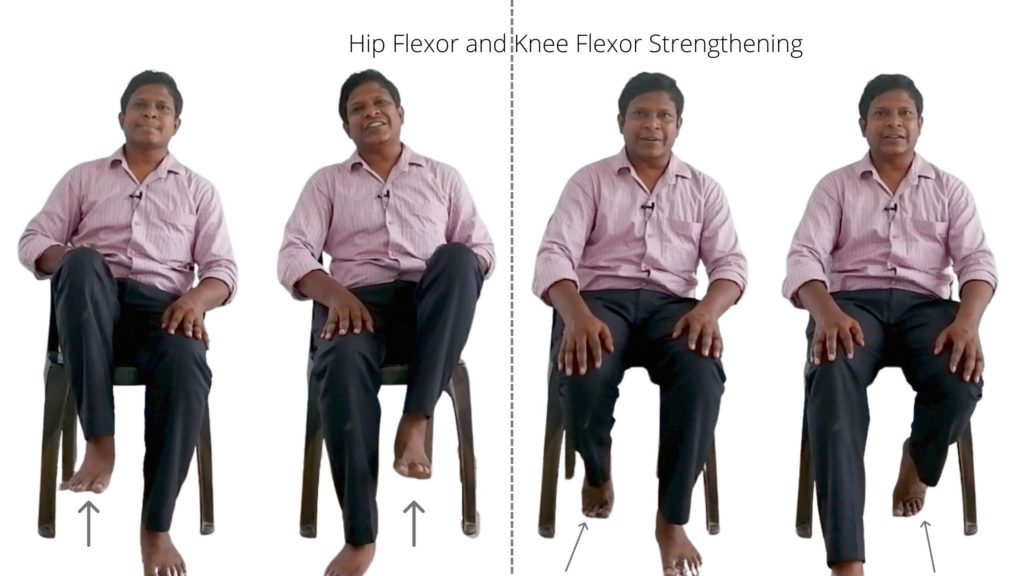
Let’s talk about some effective hip exercises.
- First up, you’ll need to sit up straight so that your hip and knees are both at 90 degrees.
- Once you’re in position, lift your hip upwards as shown in the figure. Repeat this exercise 10 times for each leg, but if you can do more, the better.
- The goal is to build strength in your hip muscles, so make sure you do at least ten repetitions per leg.
- This exercise is excellent for improving your overall hip flexibility and can help alleviate any discomfort you may be experiencing in that area.
#10 Hip external rotators strengthening exercise
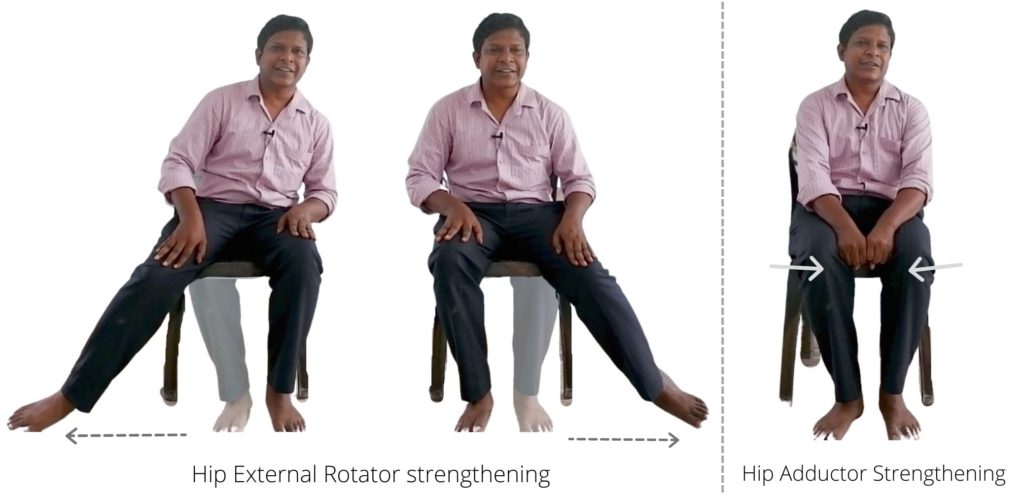
Please do not get confused by the name of the exercise; it is very easy; let me simplify it for you. Sit straight on the chair; let us start with the left-side hip external rotator strengthening exercise.
For the left side hip, take your left leg and step it outside, as displayed in the figure. Step it as further as possible and return it to its normal position. Repeat this five times on the left side and then perform it on the right.
Also read: Respiratory symptoms in elderly may predict life expectancy
#11 Hip abductor exercises for elderly
The hip abductor muscles are a group of muscles located on the inner side of the thigh. Their primary function is to move the hip joint towards the body. To strengthen these muscles, you can follow this exercise:
- Firstly, make fists with both hands and join them together.
- Then, place the joined fists between your knees, as shown in the figure.
- Next, press the fists with both your thighs and hold for 5 seconds. Release the pressure and relax for a few seconds.
- Repeat this process ten times.
Gentle Knee Exercises for Seniors in a Chair
The knee exercises we will cover here must only be performed in sitting. If you have an OA knee and want to learn more exercises, watch this knee pain exercises for elderly video. With this, let us proceed to knee pain chair exercises for seniors.
#12 Knee extension exercise
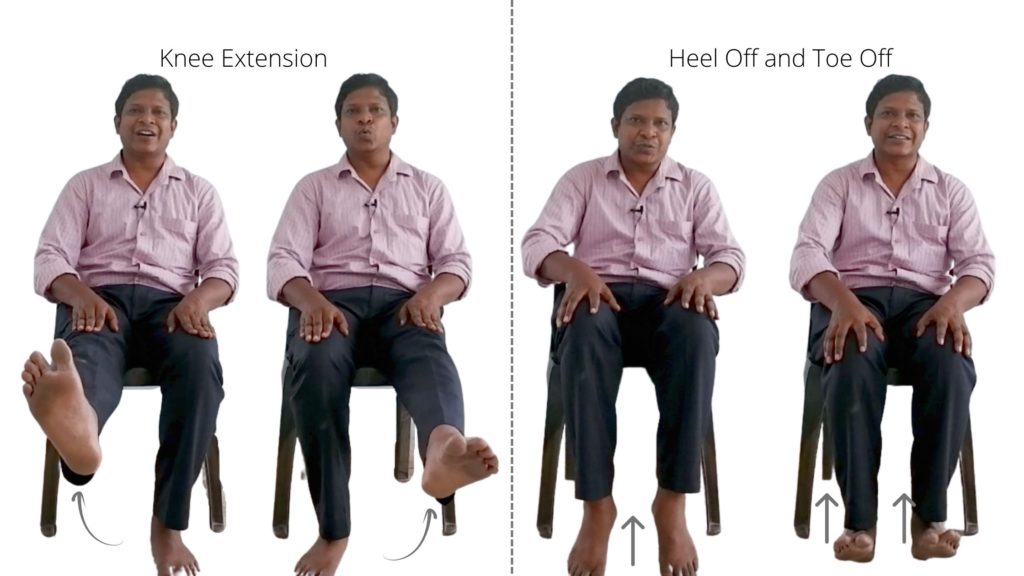
Let’s move on to the knee exercises. The first exercise involves straightening the knee, which can be done while sitting.
- To perform this exercise, straighten your leg as much as possible and hold the position for a few seconds before releasing.
- Repeat this movement 20 times, alternating between each leg for ten repetitions per leg.
This exercise is particularly beneficial for strengthening the quadriceps muscles, which are large muscles on the front of your thigh. Strengthening these muscles can help improve overall knee stability and support proper alignment of the knee joint.
#13 Heel raise and Toe raise
In this exercise, we will do heel raises, which involve lifting your heel and standing on your toes.
The heel raise exercise in sitting is a simple exercise that can help strengthen the muscles in your calves.
- To perform this exercise, sit on a chair with your feet flat.
- Then, slowly lift your heels off the ground while keeping the balls of your feet on the floor.
- Hold this position for a few seconds, then slowly lower your heels.
- Repeat this movement for several repetitions.
Summary of all the exercises
| Body Area | Exercise | Reps/Sets | Benefits |
|---|---|---|---|
| Neck | 1. Neck Side Bend | 3-5 each side | Relieves stiffness |
| 2. Neck Rotation | 10-15 each side | Improves mobility | |
| 3. Neck Flexion-Extension | 5-10 reps | Reduces tension | |
| 4. Neck Stretching | 30 sec hold | Muscle relaxation | |
| Shoulders | 5. Shoulder Abduction | 10 reps | Improves mobility |
| 6. Triceps Strengthening | 10 reps | Arm strength | |
| 7. Shoulder Shrug | 10 reps | Reduces tension | |
| Upper Back | 8. Upper Back Stretch | 30 sec hold | Relieves tightness |
| Hips | 9. Hip Flexor Exercise | 10 reps | Strengthens hips |
| 10. Hip External Rotators | 5 reps each | Improves stability | |
| 11. Hip Abductors | 10 reps | Inner thigh strength | |
| Knees | 12. Knee Extension | 10 reps | Quad strengthening |
| 13. Heel/Toe Raises | 10-15 reps | Calf strength |
Recommended Equipment for Chair Exercises
These affordable tools can enhance your seated workout routine:
Why We Recommend These Products
After working with hundreds of seniors in our physiotherapy practice, we’ve carefully selected these affordable tools that truly enhance seated workouts while prioritizing safety:
✓ Resistance Bands
- Progressive difficulty – Start with light resistance and gradually increase
- Joint-friendly – Smooth tension reduces impact on arthritic joints
- Versatile – Enhances both upper and lower body exercises
- Proven results – Studies show 40% better strength gains vs bodyweight alone
✓ Balance Cushion
- Activates core muscles – Engages abs without risky standing movements
- Improves posture – Encourages proper spinal alignment during exercises
- Fall prevention – The non-slip surface reduces sliding risks
- Dual-purpose – Can also be used as a comfortable seat cushion
✓ Light Dumbbells
- Arthritis-friendly – Neoprene coating is easier to grip than metal
- Prevents muscle loss – 1-3lbs is ideal for combating sarcopenia
- Controlled progression – Available in 0.5lb increments for safe advancement
- Compact storage – Takes less space than water bottles (common alternative)
Note: While we earn a small commission if you purchase through our links, this never increases your price. As physical therapists, we only recommend equipment we’ve personally tested for senior safety.
Final words
With age, there are so many other systemic and lifestyle diseases that can affect the quality of life. Exercise and an active lifestyle are key to so many health issues. Like, exercises are crucial to lowering blood sugar in diabetics, and there are exercises to stop urine leakage issues.
Nany elderly also suffer from asthma, and Mesothelmia, a fast-spreading deadly cancer that primarily affects the lungs, should follow breathing exercises for asthma. A study has also revealed that healthy lifestyle can reduce risk of dementia in seniors.
FAQ
The author is a physiotherapist who has been practising for the last 17 years. He holds a Bachelor's in Physiotherapy (BPT) from SVNIRTAR (Swami Vivekananda National Institute of Rehabilitation and Research), one of the prestigious physiotherapy schools in India.
Whatever he learns dealing with his patient, he shares it with the world through blogs and e-books. He also owns a YouTube channel, "Sunit Physiotherapist" with over 8 lakh active subscribers. Here, he shares everything he gets to learn serving the patient.






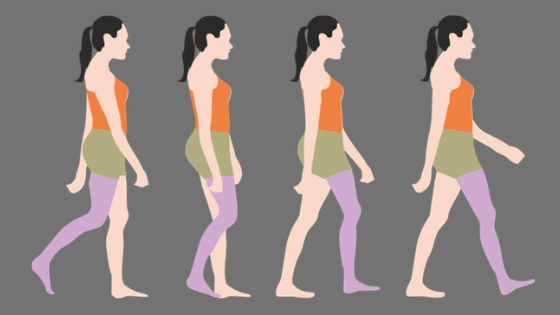


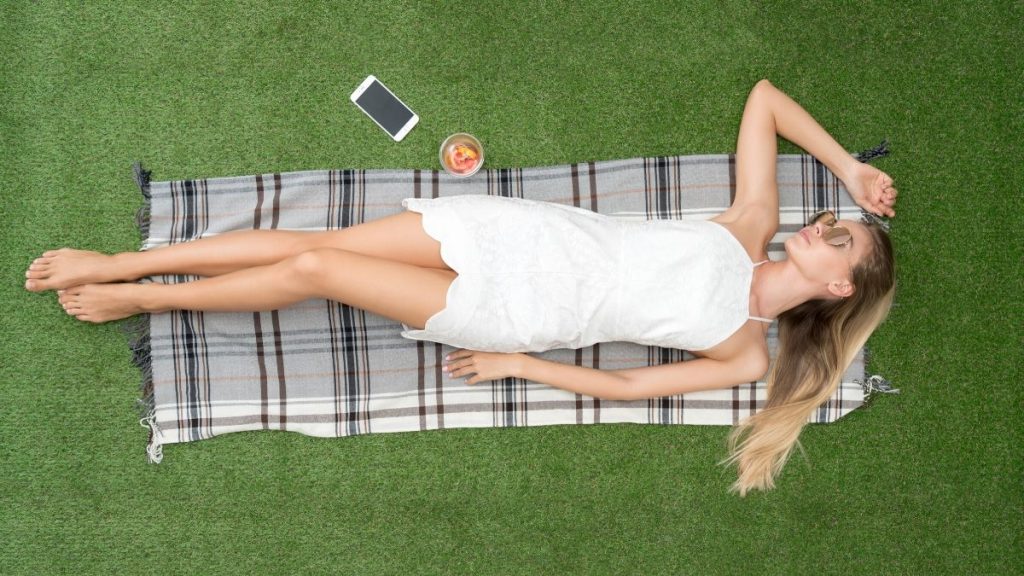
Pingback: Follow These 7 Easy Low Back Stretches for Back Pain That Actually Work - Physiosunit
Excellent exercise suggestions for people with mobility issues. Thank you.